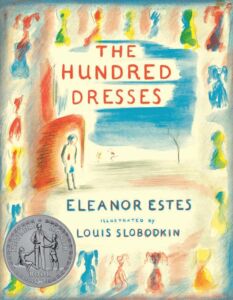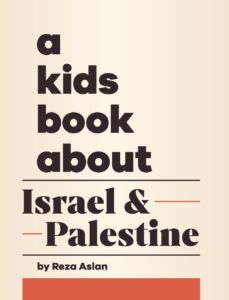by Reza Aslan
Meet a Kids Co., 2024
The recently published a kids book about Israel and Palestine was issued as part of Dorling Kindersley’s “a kids book about” series. (All titles are lower case.) It’s a series with a mission: “to empower a new generation of kids through diverse storytelling.” Those two buzzwords -- “empower” and “diverse” -- signal something else: a heavy emphasis on currently fashionable, sometimes controversial, causes. Parents and teachers who think it is important to discuss issues like gender, diversity, feminism, anxiety, racism, body image, failure, nonbinary, and bullying won’t be disappointed if they visit the kids book about website, where they’ll find a book on each of these “relevant topics that are crucial to our current times, made simple and approachable for kids aged 5-9.”
Some parents, however, may be less impressed. They may think that parents don’t need mediation to discuss controversial issues with their children, that we’re overloading kids with “relevant topics” and robbing them of their childhood innocence. They may want to raise children steeped in their family’s values, not the values of popular culture. They may even choose to wait until their children are older to discuss just how fraught and polarized the world really is.
a kids book about Israel and Palestine aims to “help cultivate empathy in children. It can teach kids to see the world through others’ eyes promoting compassion and a sense of shared humanity.” But the kids book about series already offers a kids book about Empathy. So why a book on Israel and Palestine? Is it because, as author Reza Aslan explains, “[T]his tiny part of the world gets a ton of attention?”
Which begs the question: Is the media’s obsession with Israel really the best reason to introduce this complex conflict to kids between the ages of five and nine, the book’s target audience? The author believes he’s succeeded in telling the story fairly. He trusts that encouraging kids to “walk in the shoes of individuals on both sides” is essential to “cultivate a garden where understanding blooms and the roots of tolerance deepen.”
But presenting both sides of a century-old conflict fairly requires mastery of the facts, and in Aslan’s version of the history of the Middle East conflict, many critical happenings are ignored. Did Aslan do the necessary historical research, then decide to omit these events because they were too complicated to explain to young readers, or was he unaware of the full course of Jewish history in the Middle East?
Myth or Fact?
Tracking the names of the region back through time, Aslan recognizes that “[t]hroughout history, this small part of the world has had many names: Canaan, Israel, Judea, the Southern Levant, and Syria-Palaestina are just a few.”
However, when he later mentions that some Jews fled Europe to escape the Nazis, he identifies Palestine as “the land they regarded as the Jewish historical home” (my emphasis), presenting the historical fact of Jewish presence -- attested by both archeological and written records – in Judea and the northern kingdoms, starting in approximately 1200 BCE, as a purely subjective perspective. It’s not the Jews’ “historical home” because Jews “regard” it as such. Jews constituted a political entity in Judea from biblical times (under King David) until the destruction of the Second Temple in 135 CE; in fact, there was never a period when Jews did not live there. Even when exiled by the Romans, there were enclaves where Jews hung on (Safed, Tiberias, Hebron, the Galilee and Jerusalem).
Aslan also minimizes the longstanding Jewish presence in Palestine in a different context. Referring to Britain’s support for Jewish immigration and the formation of a “separate national home for the Jewish people” there, he contends that “many people who had been living in Palestine for generations were against the idea of dividing the land into 2 separate states” – clearly referring to the Arabs. He thus erases the many Jews who had also been living in Palestine for generations; though they did not form the majority of Palestinians pre-1948, there were many – 630,000 in 1947. He also overlooks pre-’48 in-migration driven by the prospect of decent wages in the growing economy generated by enterprising Zionists. The idea that the entire Arab population of Palestine was there from time immemorial is a self-serving myth designed to paint Zionist Jews as latter-day colonialist interlopers and Arabs as indigenous to the land.
In fact, as Middle East historian Daniel Pipes explains in his article A Muslim Aliyah Paralleled a Jewish Aliyah (“aliyah” means immigration) –
Much less famously, a large and diverse non-Jewish immigration to Palestine (meaning here, roughly Gaza, the West Bank, and the northern half of the State of Israel), mostly Muslim, has also taken place. These immigrants included Arabs, Muslims, and many others. They and their descendants probably make up a majority of the population now called Palestinian. Palestinians, in other words, are not an aboriginal, autochthonous, first, indigenous, or native people; most of them are as recently arrived as Zionists. They are also as ethnically diverse.
Eliding Jewish History
To address the Middle East conflict without recognizing the long, continuous Jewish presence in the region is to erase the Jewish side of the story – a side objectively attested by historical and material evidence. Here are a few historical facts kids won’t learn from a kids book about Israel & Palestine:
- That Jews lived on and off in Hebron from biblical times to the present.
- That Jews were living in Jerusalem in the Middle Ages and slaughtered by Crusaders.
- That Palestine was governed for four hundred years (from 1517 to 1917) by the Ottoman Turks.
Instead, Aslan compresses well over a thousand years of Middle Eastern history into a few politically loaded lines: “Whatever people have called this place,” Aslan claims, “Christians, Jews, Muslims, and other religious groups have been sharing this land for a very, very, very long time—going about their daily lives, practicing their religion, and more or less getting along with each other.”
He then jumps directly from this distortion of historical intercommunal relations to the Holocaust, the event to which he attributes the establishment of the State of Israel.
Reading between the lines, his message to kids is a familiar anti-Zionist trope: Over the course of history, Jews and Muslims got along well in the Middle East. Then, the Holocaust happened in Europe, and Europeans gave Palestine to the Jews, even though the Holocaust wasn’t the Palestinians’ problem.
“More or less getting along?”
The myth of intercommunal harmony is belied by historical facts. As historian Georges Bensoussan explains, Islamic supremacy is inherent in Muslim doctrine, with Jews and Christians having only dhimmi (“protected person”) status in the Islamic polity. Thus, any political arrangement which guarantees equality of Jew and Muslim is anathema to Muslim religious doctrine and provokes a strong negative reaction.
For example, when the Turkish Mehemet-Ali, Viceroy of Egypt, came to power in 1834, he attempted to modernize his kingdom, which included what was then called “Southern Syria” (not Palestine). He introduced equality of taxation, a lottery for conscription, and opened administrative positions to Jews and Christians.
This angered the hitherto-favored Muslim population, and anti-Jewish pogroms broke out in Nablus, Hebron, Bethlehem and Safed in May 1834; as Bensoussan describes it, “Furious farmers . . . attacked the Jews, destroying their homes and committing all manner of violence.” Women were raped and synagogues set on fire. The pogrom lasted thirty-three days. A similar pogrom, this time perpetrated by Druze and Arabs, occurred in 1838.
Intercommunal Relations Under the British Mandate
Following upon the 1917 Balfour Declaration supporting a “Jewish home” in Palestine and the League of Nations’ British Mandate for Palestine in 1922, Arab anti-Jewish violence took on a new cast -- that of antisemitism. By the 1920s, Arab anti-Zionism was drawing heavily on Western sources of antisemitism, including the forgery The Protocols of the Elders of Zion, which accused Jews of a plot to control the world, and Christian antisemitic motifs, like the killing of Christ by the Jews. Leaflets distributed in Jerusalem and Jaffa in 1919 compared Jews (not Zionists, but Jews) to “poisonous snakes.” During the Nabi Mussa pilgrimage of 1920, crowds chanted, “We will drink the blood of the Jews,” then massacred and killed them in Jerusalem. This was followed by another pogrom a year later. Nor were Palestinian Arabs innocent of the Holocaust. Their leader Haj Amin al-Husseini spent World War II in Berlin, where he met with Hitler and broadcast pro-Nazi incitement to the Middle East.
Distorting History
Though a kids book about Israel & Palestine is sparing on historical facts, it manipulates the little history it presents to offer a pro-Arab account. Here are a few examples:
- The Arabs rejected the 1947 partition plan, which the Jews accepted, because it “was unacceptable for a lot of reasons, one of which was that the Arabs were given less than ½ of the land, even though they made up 2/3 of the population.”
To a child who understands fractions, this would of course sound grossly unfair. What Aslan fails to disclose is that the larger portion offered to the Jews was primarily desert or malaria-infested swampland. Moreover, the Arab Palestinians had already been given the entire east bank of the Jordan river (Transjordan), hived off from the original British mandate.
- “[N]early a million Palestinians were forced out of their homes. Many fled to neighboring countries where, to this day, they and their children are still living as refugees.”
Aslan’s figure for the number of Palestinian refugees in the War of Independence is inflated. Responsible historians put it at 650,000 – 700,000. And while some were driven out of their homes (about a third, according to Israeli historian Benny Morris, who cares about accuracy, not ideology), many fled from fear, as people do in war zones, and many because Arab leaders told them to get out of the way of the fighting.
In fact, in Haifa, according to Morris, “it was the Arab leadership that called on its population to evacuate; the Jewish mayor, Shabtai Levy, and the Histradrut labor federation activists asked them to stay.”
If the book’s goal is to tell “both sides” of the story, why does it omit to mention the flight of Jews from villages like Hartuv and Hebron (1929), Bnei Yehuda (1920), and Kfar HaShiloach (1936-37), and the ethnic cleansing of Jews from the Old City of Jerusalem in 1948? And why is the exodus of Jewish refugees from Arab lands (estimated at over 1,000,000) omitted from the book’s calculus?
- “Over the next few decades,” Aslan continues, “Israel and its neighboring Arab countries fought many more wars against each other. And Israel continued to win those wars, each time gaining more and more Palestinian territory.”
Reading this, the uninformed child or adult reader will walk away from a kids book with a picture of Israel as an imperialist land thief. But these were defensive wars fought against an enemy determined to wipe Israel off the map, not to “gain more and more territory.” It may come as a surprise to Aslan, but it’s an undeniable historical principle that, if you start a war and lose, what you may lose may be land.
- Aslan characterizes Israeli settlements as illegal encroachments on “land which was supposed to be Palestine,” and as the cause of the “protests and marches” of Palestinians.
But the fact that the United Nations deems the settlements illegal doesn’t make them so. The United Nations is notoriously biased against Israel, with non-democratic states sitting in judgement on Israel, a democracy, and using attacks on the Jewish state to deflect attention from their own democratic deficits. Moreover, there are plenty of legal opinions by scholars of international law, like Eugene Kontorovich and Ambassador Alan Baker, deeming the settlements legal. If Aslan truly intends to tell both sides of the story, he should state clearly that the legality of the settlements is disputed, not decided.
As for the “protests and marches,” these were never the Palestinian equivalent of the American civil rights movement’s Selma to Montgomery march; they took the form of two intifadas; the second intifada in particular, with its terrorist suicide bombings, resulted in over 1000 Israeli deaths and many maimings. And in any case, Arab terrorism didn’t begin with the settlements. As we’ve seen, it began in the nineteenth century, before there was an Israel, and has never stopped.
Finally, to what does the phrase “land which was supposed to be Palestine” refer? If the land Israel acquired after the ’67 war was “supposed to be Palestine,” why isn’t it? Could it be because the Arabs rejected the 1947 UN partition plan and started a war instead? Because Yasser Arafat rejected Prime Minister Ehud Barak’s generous offer of 97% of the West Bank in 2000? Or because the Arabs rejected Prime Minister Ehud Olmert’s offer to withdraw from almost the entire West Bank in 2008?
Not a Land Dispute
Aslan presents the knotty Arab-Israeli problem as a “conflict about the land, and how to fairly share it, so everyone living there could feel safe and valued.” Would that it were so simple. In fact, it’s not about how much of the disputed land each side gets. It’s that Israel insists on its right to exist as a sovereign state, while for the other side, Israel’s extinction is non-negotiable. That is why they have consistently rejected plans for partition.
The goal of a kids book about Israel & Palestine is to teach kids to listen to the other side, a very fine goal indeed. But if what the other side wants is your extinction, there is nothing to listen to.
Cultivating Sympathy in Children
You can’t simplify the history of the Middle East for young readers, and you can’t explain the current conflict without explaining its history. Since terms like “dhimmi,” “pogrom,” “Ottoman Empire,” “British Mandate,” “Holocaust,” and “refugee” are essential to understanding the conflict, a kids book about Israel & Palestine serves no useful purpose – unless its real agenda is to indoctrinate the parents (who, Aslan insists, should read the book with their child) with an oversimplified, pro-Palestinian version of the issue.
As for “help[ing] cultivate empathy in children” and “teach[ing] kids to see the world through others’ eyes, [thus] promoting compassion and a sense of shared humanity,” I would suggest a different book.
I taught elementary school, mostly fourth and fifth grade, for 35 years. Like most teachers, I had to deal with bullying in my classroom and on the schoolyard. I love children’s literature, and one day, I came upon a classic text – Eleanor Estes’s The Hundred Dresses, a Newbery Honor winner in 1945. It’s a story of the mean-spirited teasing of an immigrant child, Wanda Petronski, by her classmates, as seen through the eyes of Maddie, one of the girls involved in Wanda’s persecution.

The teasing happens mainly in the playground, out of earshot of the teacher, who plays a critical role only at the end of the story, after receiving a letter from Wanda’s father explaining why he pulled his children out of the school: “No more holler Polack. No more ask why funny name.”
Wanda has no friends; every day, she stands on the periphery of a circle of girls who admire each other’s pretty clothes. One day, tentatively approaching the girls’ circle in hopes of fitting in, Wanda announces, “I have a hundred dresses at home, all lined up.” But Wanda wears the same unpressed faded blue dress to school every day, and this launches the girls’ relentless teasing of the outsider.
It’s Wanda’s disappearance from school, and the teacher’s firm chastisement of the class for having driven the Petronski family away that precipitates Maddie’s self-examination at the end of the story: “Nothing would ever seem good to her again, because just when she was about to enjoy something … she’d bump right smack into the thought that she had made Wanda Petronski move away.”
The climactic scene happens at night:
At last Maddie sat up in bed and pressed her forehead tight in her hands and really thought. This was the hardest thinking she had ever done. After a long, long time she reached an important conclusion. She was never going to stand by and say nothing again. If she ever heard anybody picking on someone because they were funny looking or because they had strange names, she’d speak up. Even if it meant losing Peggy’s friendship. She had no way of making things right with Wanda, but from now on she would never make anybody else so unhappy again.
Every September, I’d read this short-but-perfect book to my class. It teaches every lesson Reza Aslan claims for a kids book about Israel & Palestine, but from a child’s perspective, not an adult’s. It indoctrinates appropriately – not about ideology, which has no place in school, but about kindness. No parent ever objected to my using The Hundred Dresses in school, because I had no hidden agenda. I wanted my students to learn not to bully each other, and whenever there was an incident of bullying in my class, I’d turn to them and ask, “Remember how Wanda Petronski felt? What could you have done when you saw the kids picking on Johnny?”
That’s how you teach empathy. Geopolitics has nothing to do with it.
-Reviewed by Marjorie Gann/Feb. 11, 2025

 Education Institute
Education Institute

